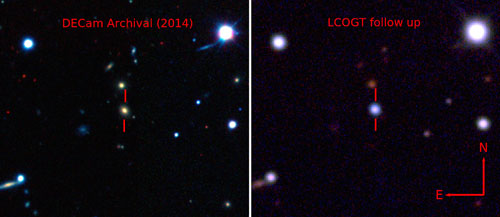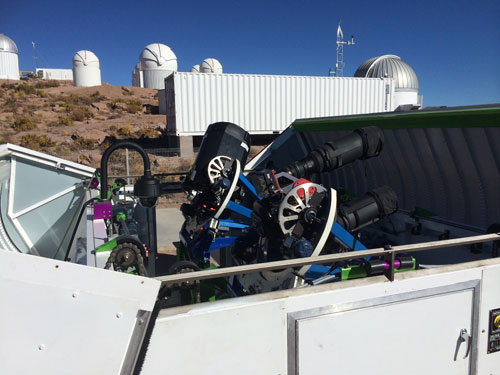Brightest Supernova Baffles Astronomers:
The most luminous supernova ever discovered, ASASSN-15lh, challenges a popular theory for blazingly bright exploding stars.

The left image shows the yellow-orange host galaxy prior to the supernova's discovery, captured by the Dark Energy Camera. The righthand image, from Las Cumbres Observatory Global Network, shows the supernova, whose blue light outshines its host.
The Dark Energy Survey / B. Shappee / The ASAS-SN Team
The Dark Energy Survey / B. Shappee / The ASAS-SN Team
About six months ago, we alerted readers to the discovery of the most luminous supernova ever. Now the discovery team is releasing additional information, and it strains even the most extreme physical scenarios.
The explosion of light initially appeared in June 2015 as the faintest of dots in automated images taken by the All-Sky Automated Survey for Supernovae (ASAS-SN), which repeatedly observes the same areas of sky to look for ephemeral bursts of light. Sophisticated software spotted the sudden but subtle influx of light, prompting astronomers to go fishing for follow-up observations at several telescopes. They soon found that the light from the source, dubbed ASASSN-15lh, had traveled for 2.8 billion years to reach Earth.
Due to its distance, ASASSN-15lh only reached about 17th magnitude at its brightest, but its luminosity outshone any supernova yet discovered. Even months later, this single object continues to emit more energy per second than all the stars in the Milky Way.

This image shows two of the 14-cm telescopes used in the All-Sky Automated Survey for SuperNovae that discovered ASASSN-15lh.
Wayne Rosing
Wayne Rosing
Subo Dong (Peking University, China) and colleagues released an update to the discovery data in January 15th’s Science. Following a spate of follow-up spectra, the team continued to track the supernova’s goings-on using the Las Cumbres Observatory Global Telescope Network (LCOGT; see the October 2012 issue of Sky & Telescope for more on this ambitious project) and the Swift space telescope. The light curves they obtained showed how the supernova’s brightness changed over time.
They also documented an outpouring of energy that challenges the extreme scenarios that attempt to explain this rare event.
Assassinating Expectations

The light curve of ASASSN-15lh outshines other supernovae, even those in its "superluminous" class. At its peak, ASASSN-15lh was 200 times as bright as a typical Type Ia supernova and twice as bright as the previous record-holder, iPTF13ajg.
ASASSN-15lh exhibits characteristics typical of exploding stars (such as blue-colored light that brightens suddenly before fading more gradually away). It lacks hydrogen and helium lines in its spectrum, so it looks similar to Type Ia supernovae, which come from exploding white dwarfs.
But its brightness puts it in the class of so-called superluminous supernovae. These rare diamonds in the rough shine about 10 times brighter than their more common Type Ia cousins, and ASASSN-15lh is the brightest of its class.
Even among its peers it’s a bit odd, because the explosion appears to be much hotter than normal. Its home is unusual, too, a bright but otherwise unassuming galaxy that forms less than a star per year. Previous superluminous supernovae have been found in furiously star-forming dwarf galaxies. Massive stars, which live fast and die young, are expected in star-forming regions, but not necessarily in the stagnant environment where ASASSN-15lh appears to reside.
Astronomers have a hard time explaining why superluminous supernovae exist. One scenario, used to explain other objects in ASASSN-15lh’s class, says that the outer layers of a massive exploding star collide violently with material around the star, making the explosion appear brighter in the process. But ASASSN-15lh’s spectrum doesn’t display any hydrogen lines, which would be common in the circumstellar material, so this explanation is ruled out straightaway.
Another scenario, and perhaps the most promising to date, suggests a more exotic power source. When a massive (but not too massive) star goes supernova, its core implodes to form a spinning neutron star. And if the circumstances are right, these crushed stellar remains could carry extreme magnetic fields, potentially 100 trillion times the average magnetic field on the Sun. These super-magnetic, rapidly spinning neutron stars, called magnetars, could power something far brighter than an ordinary exploding star.
Magnetars could explain other superluminous supernovae, but this time there’s a catch. Already, ASASSN-15lh has emitted more energy than a magnetar could provide: 1052 ergs, or 100 billion times more than what the Sun emits over the same time period. And that’s only the energy emitted over the supernova’s first four months, which is what’s published in the Science paper. “Now we have collected a few months more data,” Dong adds, “and the integrated luminosity has exceeded 1052 by considerably more.”
“To me, magnetars have played in recent times the role of jokers in card games,” says Tsvi Piran (Racah Institute of Physics, Israel). “Whenever one needs an additional energy source, a joker is invoked. If you look at the wide range of ways that magnetars have been invoked to operate, you can see clearly that not all of them can work at the same time.”
That’s not to say we’re out of options. Other exotic scenarios abound, such as pair-instability supernovae or newborn quark stars.Time (and continued observations) will tell.
1 comment:
Thanks for sharing this blog with us this is really nice blog if you are looking for a wildlife tour in corbett so get us, and make your trip best Corbett National Park
Post a Comment